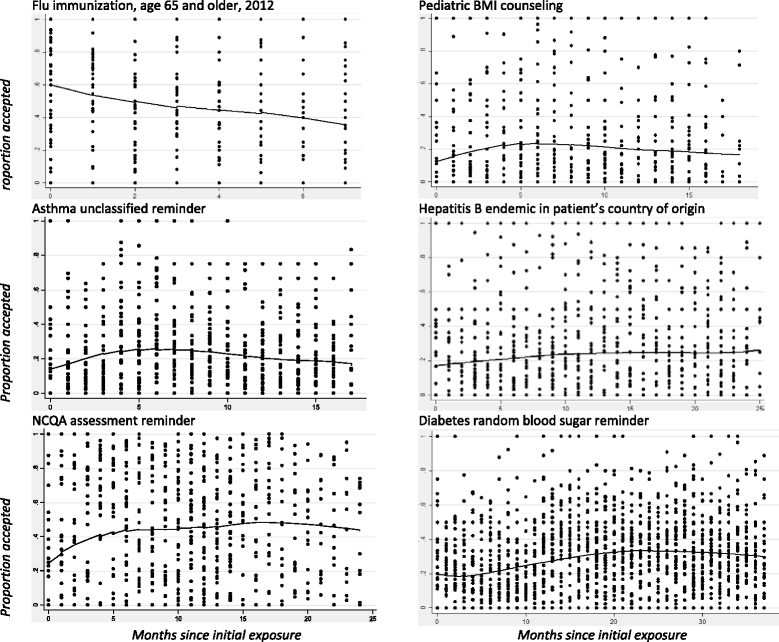Effects of workload, work complexity, and repeated alerts on alert fatigue in a clinical decision support system
- PMID: 28395667
- PMCID: PMC5387195
- DOI: 10.1186/s12911-017-0430-8
Effects of workload, work complexity, and repeated alerts on alert fatigue in a clinical decision support system
Erratum in
-
Correction to: Effects of workload, work complexity, and repeated alerts on alert fatigue in a clinical decision support system.BMC Med Inform Decis Mak. 2019 Nov 18;19(1):227. doi: 10.1186/s12911-019-0971-0. BMC Med Inform Decis Mak. 2019. PMID: 31739801 Free PMC article.
Abstract
Background: Although alert fatigue is blamed for high override rates in contemporary clinical decision support systems, the concept of alert fatigue is poorly defined. We tested hypotheses arising from two possible alert fatigue mechanisms: (A) cognitive overload associated with amount of work, complexity of work, and effort distinguishing informative from uninformative alerts, and (B) desensitization from repeated exposure to the same alert over time.
Methods: Retrospective cohort study using electronic health record data (both drug alerts and clinical practice reminders) from January 2010 through June 2013 from 112 ambulatory primary care clinicians. The cognitive overload hypotheses were that alert acceptance would be lower with higher workload (number of encounters, number of patients), higher work complexity (patient comorbidity, alerts per encounter), and more alerts low in informational value (repeated alerts for the same patient in the same year). The desensitization hypothesis was that, for newly deployed alerts, acceptance rates would decline after an initial peak.
Results: On average, one-quarter of drug alerts received by a primary care clinician, and one-third of clinical reminders, were repeats for the same patient within the same year. Alert acceptance was associated with work complexity and repeated alerts, but not with the amount of work. Likelihood of reminder acceptance dropped by 30% for each additional reminder received per encounter, and by 10% for each five percentage point increase in proportion of repeated reminders. The newly deployed reminders did not show a pattern of declining response rates over time, which would have been consistent with desensitization. Interestingly, nurse practitioners were 4 times as likely to accept drug alerts as physicians.
Conclusions: Clinicians became less likely to accept alerts as they received more of them, particularly more repeated alerts. There was no evidence of an effect of workload per se, or of desensitization over time for a newly deployed alert. Reducing within-patient repeats may be a promising target for reducing alert overrides and alert fatigue.
Keywords: Alert fatigue; Clinical decision support; Electronic health records.
Figures

Similar articles
-
Clinical reminder alert fatigue in healthcare: a systematic literature review protocol using qualitative evidence.Syst Rev. 2017 Dec 13;6(1):255. doi: 10.1186/s13643-017-0627-z. Syst Rev. 2017. PMID: 29237488 Free PMC article.
-
Evaluation of clinician interaction with alerts to enhance performance of the tele-critical care medical environment.Int J Med Inform. 2020 Jul;139:104165. doi: 10.1016/j.ijmedinf.2020.104165. Epub 2020 May 6. Int J Med Inform. 2020. PMID: 32402986
-
Overrides of medication-related clinical decision support alerts in outpatients.J Am Med Inform Assoc. 2014 May-Jun;21(3):487-91. doi: 10.1136/amiajnl-2013-001813. Epub 2013 Oct 28. J Am Med Inform Assoc. 2014. PMID: 24166725 Free PMC article.
-
A systematic review of the effectiveness of interruptive medication prescribing alerts in hospital CPOE systems to change prescriber behavior and improve patient safety.Int J Med Inform. 2017 Sep;105:22-30. doi: 10.1016/j.ijmedinf.2017.05.011. Epub 2017 May 27. Int J Med Inform. 2017. PMID: 28750908 Review.
-
Sharpening clinical decision support alert and reminder designs with MINDSPACE: A systematic review.Int J Med Inform. 2024 Jan;181:105276. doi: 10.1016/j.ijmedinf.2023.105276. Epub 2023 Nov 2. Int J Med Inform. 2024. PMID: 37948981 Review.
Cited by
-
Use of machine learning to predict clinical decision support compliance, reduce alert burden, and evaluate duplicate laboratory test ordering alerts.JAMIA Open. 2021 Mar 1;4(1):ooab006. doi: 10.1093/jamiaopen/ooab006. eCollection 2021 Jan. JAMIA Open. 2021. PMID: 33709062 Free PMC article.
-
An Advanced Cardiac Life Support Application Improves Performance during Simulated Cardiac Arrest.Appl Clin Inform. 2024 Aug;15(4):798-807. doi: 10.1055/s-0044-1788979. Epub 2024 Oct 2. Appl Clin Inform. 2024. PMID: 39357878 Clinical Trial.
-
Digital health technologies: opportunities and challenges in rheumatology.Nat Rev Rheumatol. 2020 Sep;16(9):525-535. doi: 10.1038/s41584-020-0461-x. Epub 2020 Jul 24. Nat Rev Rheumatol. 2020. PMID: 32709998 Review.
-
Use of electronic health record best practice alerts to improve adherence to American Urological Association vesicoureteral reflux guidelines.Pediatr Surg Int. 2022 Dec 1;39(1):25. doi: 10.1007/s00383-022-05314-9. Pediatr Surg Int. 2022. PMID: 36454296
-
Flight crew fatigue risk assessment for international flights under the COVID-19 outbreak response exemption policy.BMC Public Health. 2022 Oct 1;22(1):1843. doi: 10.1186/s12889-022-14214-5. BMC Public Health. 2022. PMID: 36183066 Free PMC article.
References
Publication types
MeSH terms
Grants and funding
LinkOut - more resources
Full Text Sources
Other Literature Sources

